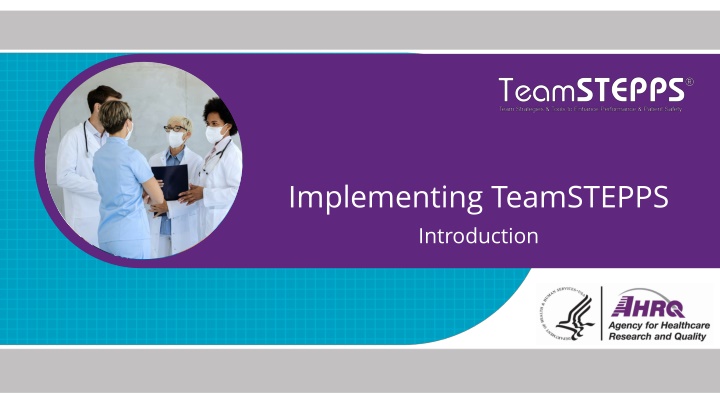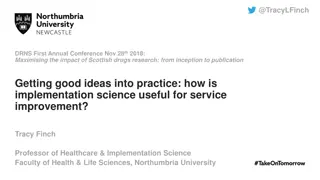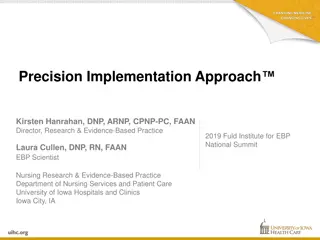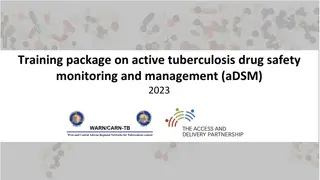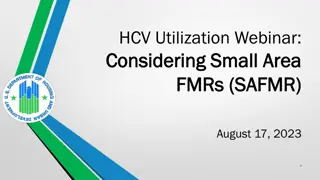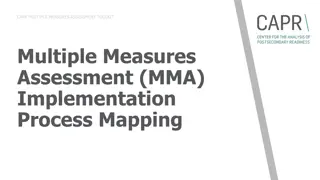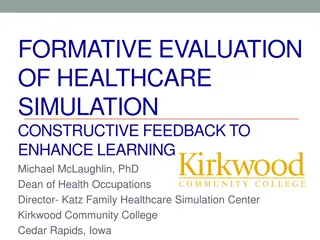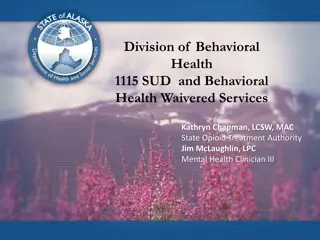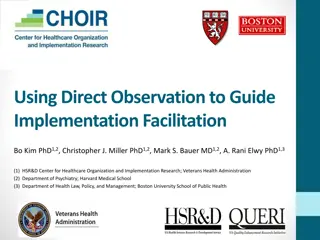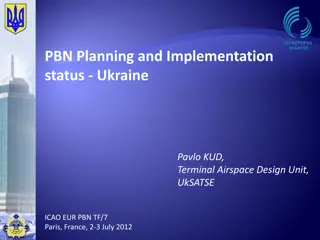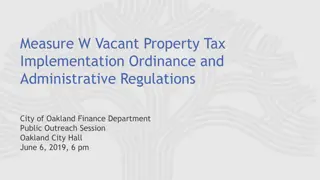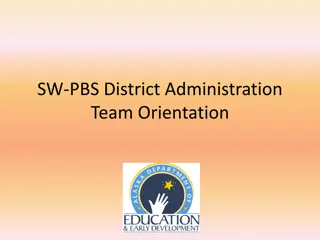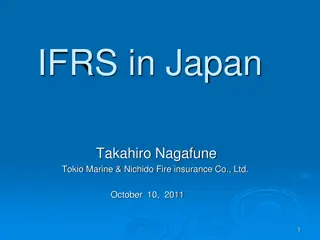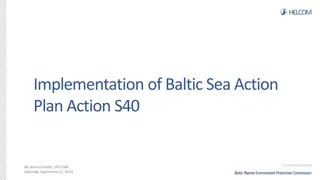Implementing TeamSTEPPS: Introduction and Implementation Process
Explore the journey of implementing TeamSTEPPS - a framework to enhance communication and teamwork in healthcare settings. Dive into pre-implementation activities, readiness assessment, change management principles, and coaching techniques. Understand the importance of addressing organizational culture and systemic failures for successful implementation. Avoid common pitfalls and prepare for a structured approach towards improving patient safety through effective teamwork and communication strategies.
Download Presentation

Please find below an Image/Link to download the presentation.
The content on the website is provided AS IS for your information and personal use only. It may not be sold, licensed, or shared on other websites without obtaining consent from the author.If you encounter any issues during the download, it is possible that the publisher has removed the file from their server.
You are allowed to download the files provided on this website for personal or commercial use, subject to the condition that they are used lawfully. All files are the property of their respective owners.
The content on the website is provided AS IS for your information and personal use only. It may not be sold, licensed, or shared on other websites without obtaining consent from the author.
E N D
Presentation Transcript
Implementing TeamSTEPPS Introduction
Day 2 Preview Reflecting on Day 1 Patient safety is threatened by poor communication and teamwork. TeamSTEPPS provides tools and a framework to improve both. Questions or reflections on day 1. 2
Day 2 Preview Preparing for Day 2 Day 1: Introduction Module 1 Communication Module 2 Team Leadership Module 3 Situation Monitoring Module 4 Mutual Support Putting It All Together Day 2: Should you implement TeamSTEPPS? Are you ready? Is there a measurable problem? How to implement TeamSTEPPS Implementation planning Coaching Change management Refining implementation Skills Coaching Implementation Practice teaching 3
Day 2 Preview Day 2 Objectives Learn to assess your readiness for TeamSTEPPS. Explain measurement s role in successful implementation. Describe key principles of change management. List key characteristics of successful coaching. Practice creating an implementation plan. Refine skills related to coaching, implementation planning, and teaching TeamSTEPPS. 4
Day 2 Preview Implementation Activity Overview 5
Implementing TeamSTEPPS: Pre-implementation Activities 6
Pre- Section Objectives Implementation Explain how to assess your organization s readiness for TeamSTEPPS. List reasons defining your problem and goals is essential. Describe options for measuring the extent of your problem and whether it is improving. 7
Pre- TeamSTEPPS is NOT a Solution for All Problems Implementation TeamSTEPPS will not: Fix problems caused by acute financial or staffing shortages. Succeed in a culture unconcerned about patient safety and focused exclusively on the bottom line. Produce significant improvements right away or with minimal sustained effort. Thrive in a culture that punishes individuals for systemic failures. Many TeamSTEPPS training participants report negligible progress implementing TeamSTEPPS 6 months after their attendance. WE DON T WANT YOU TO BE ONE OF THESE! 8
Pre- Successful Implementation Begins With Careful Pre-Implementation Planning Implementation 9
Pre- Assessing Your Readiness Implementation Lack of organizational readiness is a major reason TeamSTEPPS implementations fail. Readiness considers: Whether there is a clearly defined need. Whether organizational culture supports safety improvements. Whether time, resources, and personnel are available to implement TeamSTEPPS. Whether the organization is ready to make a SUSTAINED commitment. 10
Pre- Conducting a Readiness Assessment Implementation Who should participate: Administrative sponsor Implementation champion for the organization or unit Key clinical influencers whose support will be essential Representative staff who will be trained A knowledgeable patient How to assess readiness: Use readiness assessment tool. (https://www.ahrq.gov/teamstepps- program/curriculum/implement/pre/ready.html) Discuss results as a group. Address obstacles identified in assessment results. Examine safety culture survey results. (https://www.ahrq.gov/sops/surveys/index.html) 11
Measurement 12
Define a Measurable Goal or Problem You Plan To Address Measurement A clearly defined goal or problem will: Help make the case to administration for investing in TeamSTEPPS. Help staff understand the importance of TeamSTEPPS. Enable accountability by setting clear expectations for outcomes you seek to change. Keep the focus on patient safety. Be measurable. More guidance on defining your goal or aim is provided in the Action Planning discussion. 13
Measurement Is Foundational to Implementation Measurement 14
Measurement How To Measure Different Levels 15
TeamSTEPPS Measurement Option Overview Measurement Behavior Team Performance Observation Tool Teamwork Perceptions Questionnaire (T-TPQ) AHRQ Surveys on Patient Safety Culture Results Patient outcome and clinical process measures AHRQ Surveys on Patient Safety Culture Patient Safety Indicators Reactions Course Evaluation Form Open-ended feedback Learning Teamwork Attitudes Questionnaire (T-TAQ) Learning Benchmarks Team Performance Observation Tool Teamwork Perceptions Questionnaire (T-TPQ) 16
Level III: Behavior Measures Measurement Team Performance Observation Tool. Teamwork Perceptions Questionnaire (T-TPQ). AHRQ Surveys on Patient Safety Culture. CAHPS questions: can provide patient perceptions of some targeted behaviors. Feedback from staff, patients, and supervisors: are targeted behaviors changing? 17
Level IV: Results Measurement Outcome changes are key to sustained organizational buy-in. Staffing Measures: Job satisfaction, employee turnover, and other staff measures can show if changes are positively impacting staff. Patient Outcome Measures: Examples: Complication rates, infection rates, measurable medication errors, and patient perceptions of care and satisfaction with their care. Clinical Process Measures: Examples: Length of patient wait time, time to intubate, medication administration delays, compliance with preventive screenings, number of misdiagnoses, number of structured handoffs used. 18
Measurement AHRQ Patient Safety Indicators Level IV Results From PSIs: Provide information on potential in-hospital complications and adverse events. Can help identify potential adverse events that might need further study. Include indicators for in-hospital complications that may represent patient safety events. Quality Indicators: PSI Measures 19
Accurately and Efficiently Measuring Outcomes Measurement Use preexisting measures, which are easier to monitor and more credible to the organization than new measures you have to begin collecting. Make sure the measures you monitor are matched to the areas where you ve implemented TeamSTEPPS. Changing one unit will only have a small effect on measures tracking the entire organization. Match the time covered by the measure to the intervention period. Measure time lag can delay the availability of some measures substantially (especially if based on claims data or organizational or patient surveys). Be realistic about how long process changes take to affect outcomes. Change is rarely immediate and sometimes outcomes get worse before they start getting better. 20
Evaluating TeamSTEPPS Exercise Measurement Three nurses and the infection control officer at a 16-bed postsurgical intensive care unit attend the 2-day TeamSTEPPS Training. During the implementation planning session, the team agrees that hand hygiene compliance is a major problem, especially physician compliance. Therefore, the unit has a relatively high surgical site infection rate. The team decides to use CUS and the Two-Challenge Rule to address this issue. As part of their implementation, they train all the nurses and the employed physician staff on these two tools but struggle to get surgeons who are not employed by the hospital to participate. Once the training is complete, they decide to launch the implementation of CUS and the Two-Challenge Rule. 21
Objectives Implementation Describe the steps involved in implementing TeamSTEPPS. Develop a TeamSTEPPS Implementation Plan. 23
Shift Toward a Culture of Safety Implementation 24
Key Principles of Implementation Implementation The Implementation Guide is based on the principle of improving patient safety and quality of care by improving healthcare team processes. Key activities include: Identifying a recurring problem or opportunity for improvement. Developing a flowchart or map of the process. Studying the process to identify risk points. Implementing interventions aimed at eliminating the risk points. Testing the intervention. Sustaining positive changes. 25
10 Steps of Implementation Planning Implementation 1. 2. 3. 4. 5. 6. 7. 8. 9. 10. Review your TeamSTEPPS Implementation Plan with key stakeholders and modify according to input. Create a Change Team. Define the problem, challenge, or opportunity for improvement. Define the aims of your TeamSTEPPS intervention. Design a TeamSTEPPS intervention. Develop a plan for testing the effectiveness of your TeamSTEPPS intervention. Develop an implementation plan. Develop a plan for sustained continuous improvement. Develop a communications plan. Develop a TeamSTEPPS Implementation Plan timeline. 26
Describe the Targeted Unit/Work Area Implementation Name of targeted unit/work area: Key Actions: Describe the targeted unit or work area: Unit/Work area name Size in terms of number of beds or admissions Number of staff by profession: Size of unit/work area: Number of staff within unit/work area: Physicians: Nurses: Other: 27
Step 1: Create a Change Team Implementation Key Actions: Select a multidisciplinary Change Team. Ensure representation from different leadership levels. Ensure at least one member has substantial TeamSTEPPS training. Ensure one member or advisor has experience in performance improvement. 28
Step 2: Define the Problem or Opportunity for Improvement Implementation What existing information will you review? 1. 2. 3. Key Actions: Review unit performance and safety data: Incident reports AHRQ Patient Safety Survey Clinical process and outcome measures Review RCAs and/or FMEAs. Ask frontline staff. Conduct the Magic Wand exercise. Refer to the teamwork issue you identified on the TeamSTEPPS Implementation Worksheet as a starting point, if applicable. What new information will you collect? 1. 2. 3. What are the main problems and opportunities? 1. 2. 3. 29
Example: Problem Definition Implementation Problem: Suboptimal communication among surgical team members Team Process: What: Communication of critical information about the patient and surgical procedure Who: Surgeons, anesthesiologists, operating room nurses, and scrub technicians in the General Surgery Service When: Just prior to first incision Where: In the operating room 30
Step 3: Define the Aims of TeamSTEPPS Intervention Implementation Team Process Aims: 1. 2. 3. Team Outcome Aims: 1. 2. 3. Clinical Outcome Aims: 1. 2. 3. Key Actions: Develop one to three measurable aims. What do you hope to achieve? Who will be involved? When and where will the improvements occur? Consider including team process, team outcome, and clinical outcome aims. 31
Step 4: Design a TeamSTEPPS Intervention Implementation Key Actions: Flowchart or map the process during which the target problem/challenge/opportunity occurs. Identify risk points. Determine which TeamSTEPPS tools or strategies would work best to eliminate the process risk points. State what tools and strategies will be implemented, who will use them, when and where (Refer to your responses on the TeamSTEPPS Implementation Worksheet, if applicable). Evaluate your TeamSTEPPS intervention for potential benefits and negative effects. List the risk points you intend to address: 1. 2. 3. List the TeamSTEPPS tools and strategies that will be implemented: 1. 2. 3. List the order in which the tools and strategies will be implemented: 1. 2. 3. 32
Step 5: Develop a Plan for Testing Your TeamSTEPPS Interventions Implementation Who is responsible? At what level will you measure and what measures will you use? 1. Level I Reactions: Key Actions: Identify who on your Change Team will be responsible for data collection, analysis, and presentation (generation of graphs and charts). Identify a measure and define target ranges for that measure. Measure before and after you implement TeamSTEPPS. Consider Kirkpatrick s taxonomy when selecting measures. 2. Level II Learning: 3. Level III Behavior: 4. Level IV Results: 33
Step 6. Develop an Implementation Plan Implementation Who will attend the training sessions? Key Actions: Determine who needs to be trained on what TeamSTEPPS skills and by when. Develop a training plan for each audience. Determine if refresher training is required. Create training timelines. What skills will you train? When will the training sessions occur and for how long? Where will the sessions occur? How will you train (method of presentation, tools, supplies)? What are the logistics to consider? 34
Determine How Coaches May Be Used Implementation Will coaches be used? Key Actions: Determine whether coaches will be used to facilitate sustainment. If coaches will be used, determine: How many are needed? When and how will they be trained How will they be used? What are the expectations for the role of coaches? If Yes: Ho many are required? When will coaches be trained? How will coaches be trained? How will coaches be used? What are the expectations for the role of coaches? 35
Step 7: Develop a Sustainment Plan Implementation Identify Components of a Monitoring Plan: 1. Measures and Targeted Outcomes: Key Actions: For your monitoring plan, determine: Measures and target outcomes. Data source (e.g., existing QI database). Resources required (money, time, equipment, personnel, expertise). Person(s) responsible for implementation and oversight. Determine how data from your monitoring plan will be used to continually improve processes and performance. 2. Data Sources: 3. Resource Requirements: 4. Individual Responsible: 36
Step 8: Develop a Communications Plan Implementation Who are the stakeholders? 1. 2. What do you want to achieve? 1. 2. What information will you communicate? 1. 2. When will you communicate? 1. 2. How will you communicate? 1. 2. Key Actions: Develop a communications plan. Identify goals for communication with this group. What do you want to achieve? Who will receive the information? What information will you communicate? When and how often will you communicate? How will you communicate (e.g., reports, presentations, emails)? 37
Step 9. Develop an Implementation Plan Timeline Implementation 38
Change Team Meetings Implementation 39
Step 10: Review Your Plan With Key Stakeholders Implementation Which key stakeholders should review the plan? 1. 2. 3. 4. 5. Key Actions: Identify stakeholders who could contribute significantly to the Implementation Plan. Ask key stakeholders to review your Action Plan and to provide input. Modify your Action Plan based on their input, if needed. 40
TeamSTEPPS Implementation Planning Exercise Implementation Break into working groups by unit or by best alignment of common issues. Develop your Action Plan based on the 10-step process. Be ready to present and discuss your Action Plan with the larger group. 41
Coaching Objectives for Coaching Define coaching and its outcomes. Describe the role of a TeamSTEPPS coach. List competencies of an effective coach. Describe how to implement coaching in TeamSTEPPS. 43
TeamSTEPPS Implementation Process Coaching 44
Coaching Coaching Involves providing instruction, direction, and prompting Includes demonstrating, reinforcing, motivating, and providing feedback Requires monitoring and ongoing performance assessment Continues even after skills are mastered to ensure sustainment 45
Coaching Why Is Coaching Important? Effective coaching can result in: Clear and defined goals. Aligned expectations between team leader and team members. Just-in-time knowledge transfer. Increased individual motivation and morale. Increased ability to adapt and react. Early identification of unforeseen performance barriers. Commitment to ongoing learning and improvement. Movement toward superior team performance. 46
Why Is Coaching Important in TeamSTEPPS? Coaching Effective coaching in TeamSTEPPS further aims to achieve: Successful integration of teamwork behaviors into daily practice. Increased understanding of teamwork concepts. Increased teamwork competence among staff. Sustainment of improved performance over time. Improved team performance and safer patient care. 47
Coaching The Role of a TeamSTEPPS Coach Be a role model for desired behaviors. Observe performance and provide feedback. Motivate team members. Provide opportunities to practice and improve. 48
Coaching The Coach as a Role Model Demonstrates effective use of teamwork behaviors, tools, or strategies As a respected member of the team, reinforces acceptance of behavior through performance 49
Coaching Coaches Provide Feedback That Is Timely. Respectful. Specific. Directed toward improvement. Two way. Considerate. 50
